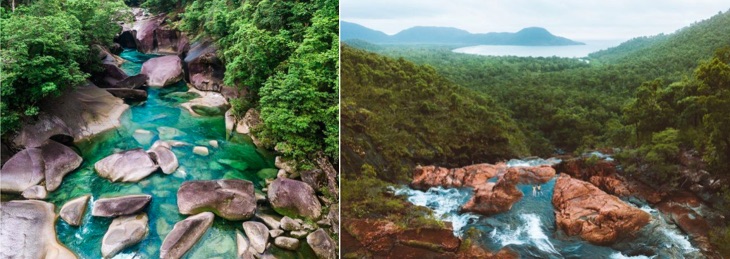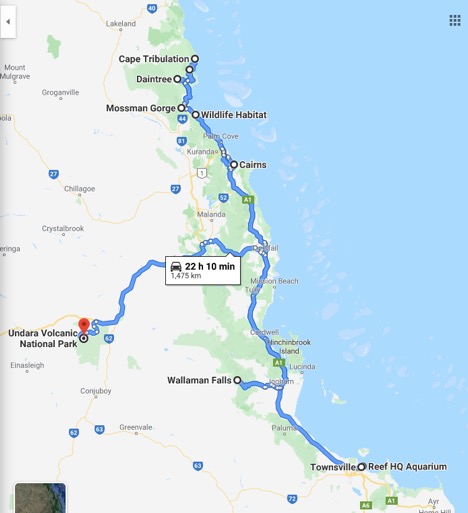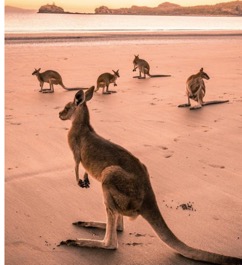Tropical North Queensland and the Great Barrier Reef Educational Adventure
 Wednesday, December 25, 2019 at 01:12PM
Wednesday, December 25, 2019 at 01:12PM The New Scientist is accepting Discovery Tour idea submissions. If your idea wins then you get two free tickets to partake. Here is my submission.
Summary: This would be an immersive educational excursion through two of Australia’s greatest World Heritage Sites: the Wet Tropics of Queensland and the Great Barrier Reef. Accompanied along the way by botanists, entomologists, ornithologist, marine biologists, and zoologists, you will take close look at the plants and animals that comprise the Daintree Rainforest (the oldest continually surviving rainforest in the world), learn about the threats facing the world’s largest coral reef system, and gain an understanding of the most biodiverse regions of Australia. Join us for this once in a lifetime opportunity to explore the jungles and coasts of Queensland.
Locations and Transportation: The two main cities that guests will sleeping in are Cairns (where there is a major airport), and Townsville. The Spirit of Queensland rail service runs passenger trains between the two cities. Island ferries and boats to the Great Barrier Reef launch from Cairns and Townsville. Visits to National Parks and other coastal or inland sites would likely require a chartered coach.

Port Douglass and Cape Tribulation, Mossman (Pics from the Daintree Ecolodge website)
Trip Length/Departing: I propose 14 days as the trip length (for those living outside of Australia it takes some time to travel there, so a longer Discovery Tour would be better). To give the New Scientist tour organizers adequate time to prepare, I suggest that this trip take place in 2021, anytime between June through October, which is outside of the rainy season (‘The Big Wet’). According to US News, “the area's low season (known locally as the wet or stinger season) takes place between November and May and brings more rain, resulting in poorer water visibility and an abundance of deadly box jellyfish.” The best time to see humpback and minke whales in the GBR is between July and September. Though travelers may not be able to avoid the mozzies and sandflies (which are prevalent after downpours and whose bites can be offset with insect repellent), ophiophobia could be eased by the fact that that fewer than 20 people have died from snake bites in Australia since 2011.

Mossman (Pics from the Daintree Ecolodge website)
Accompanying Experts:
-A representative from the Biodiversity and Geosciences Collection at the Museum of Tropical Queensland
-A scientist from the Great Barrier Reef Marine Park Authority
-A professor from the James Cook University (Townsville or Cairns campus)
-British historian and writer Andrea Wulf, author of The Invention of Nature
General Idea: Since the Cairns Airport is where most people who are arriving by plane would be flying into, that would make a sensible meeting spot. The trip would combine urban and outdoor scientific elements along the coast of the Coral Sea from Townsville (350 km south of Cairns) to Daintree (110 km north of Cairns). The urban element would consist of visiting (and perhaps attending lectures at) museums, aquariums, universities, botanical gardens, and wildlife habitats. The outdoor scientific element would involve visits to National Parks, islands, and guided treks to discover Queensland’s stunning array of land and sea animals such as kangaroos, wallabies, other macropods, koalas, cassowaries, saltwater crocodiles, sea turtles (six of the world’s seven marine turtle species reside in the GBR), manta rays, dugongs, sharks, minke and humpback whales, and a myriad of tropical insects and spiders. Obviously, the NS is particularly well-suited to incorporate educational elements of the tours (via lectures, guided tours, etc.) to help participants learn about the biodiversity and threats facing ecologically fragile places like the Daintree and GBR. I believe such a tour would be remiss in its cultural obligations if it did not include the history of the Kuku Yalanji aboriginal peoples in Queensland.
 Daintree Insects (photos from Destination Daintree)
Daintree Insects (photos from Destination Daintree)
Itinerary: While I’ll leave the day-by-day itinerary details and travel logistics to the experts (as you can see, if participants fly into Cairns they’d have to double-back through it if this itinerary is pursued), here are some ideas of places that I think NS readers and their families would enjoy. Below is 1) a short list of some notable towns and other places of interest, 2) a screenshot of some of these locations mapped out as a route in Google Maps, followed by 3) another list of more specific sites and places of interest. Left out of this route is the Great Barrier Reef.
 Babinda Boulders in Daintree, the Hinchinbrook Island (photos from Queensland Uncovered)
Babinda Boulders in Daintree, the Hinchinbrook Island (photos from Queensland Uncovered)
-Daintree Rainforest (“The most extraordinary place on Earth” - Sir David Attenborough
-Mossman Gorge
-Port Douglass
-Cape Tribulation
-Girringun National Park (home to Australia’s tallest waterfall, Wallaman Falls)
-Undara Volcanic National Park (home to the longest standing lava tubes on Earth)
-Wooroonooran National Park
-Lamington National Park
-Springbrook National Park
-Hinchbrook Island

(Left out of this itinerary are also the beaches of the Whitsunday Islands, which are regularly voted Australia’s best beaches and are three hours south of Townsville.)
In and around Cairns (considered Australia’s ‘gateway to the Great Barrier Reef’ where fruit bats fly at dusk) and Daintree:
-Paronella Park
-Skyrail Rainforest Cableway
-Emu Ridge Gallery – A fossil and gemstone museum
-Cairns Crocodile and Wildlife Park
-Port Douglass Wildlife Habitat
-Daintree Entomological Museum
-Atherton Tablelands
 Minke Whales and Sea Turtle Hatchlings (Photos from Queensland Uncovered)
Minke Whales and Sea Turtle Hatchlings (Photos from Queensland Uncovered)
In and around Townsville:
-Reef HQ (Largest coral reef aquarium in the world)
-Museum of Tropical Queensland
-Townsville Palmetum
Other:
-Mamu Tropical Skywalk
-Head down to Nudey Beach (awarded the best beach in Oz in 2018) at sundown to play the digeridoo for the kangaroos.

(Photo from Queensland Uncovered)
I found the blog site Queensland Uncovered to be helpful in preparing this submission. I have never been to Queensland but hope to go one day. If you have any questions or would like more details regarding my vision for this dream trip please do not hesitate to contact me.
Sincerely,
Aaron Dames
New Scientist Magazine Subscriber
 Aaron |
Aaron |  Post a Comment |
Post a Comment | 
Reader Comments